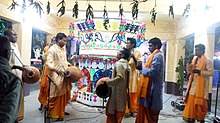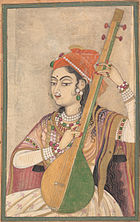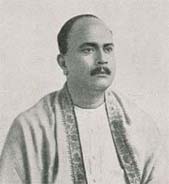
The music of Bangladesh spans a wide variety of styles. Bangladesh claims some of the most renowned singers, composers and producers in Asia. Music has served the purpose of documenting the lives of the people and was widely patronized by the rulers. It comprises a long tradition of religious and regular song-writing over a period of almost a millennium.
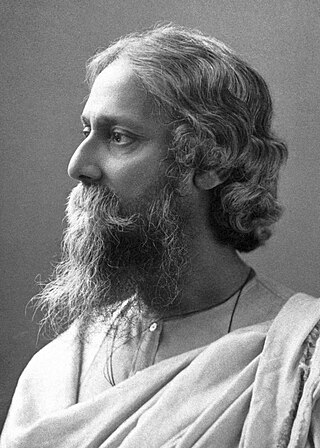
Bengali poetry is a rich tradition of poetry in the Bengali language and has many different forms. Originating in the Bengal region of South Asia, the history of Bengali poetry underwent three successive stages of development: poetry of the early age, the Medieval period and the age of modern poetry. All ages have seen different forms of poetry and poetical tradition. It reached the pinnacle during the Bengali Renaissance period although it has a rich tradition and has grown independent of the movement. Major Bengali Poets throughout the ages are Chandidas, Alaol, Ramprasad Sen, Michael Madhusudan Dutt, Nabinchandra Sen, Rabindranath Tagore, Dwijendralal Ray, Satyendranath Dutta, Kazi Nazrul Islam, Jibanananda Das, Jasimuddin, Sukanta Battacharya, Al Mahmud.

Bengali music comprises a long tradition of religious and secular song-writing over a period of almost a millennium. Composed with lyrics in the Bengali language, Bengali music spans a wide variety of styles which are mainly of Bangladesh.

Rabindra Sangeet, also known as Tagore Songs, are songs from the Indian subcontinent written and composed by the Bengali polymath Rabindranath Tagore, winner of the 1913 Nobel Prize in Literature, the first Indian and also the first non-European to receive such recognition. Tagore was a prolific composer with approximately 2,232 songs to his credit. The songs have distinctive characteristics in the music of Bengal, popular in India and Bangladesh.
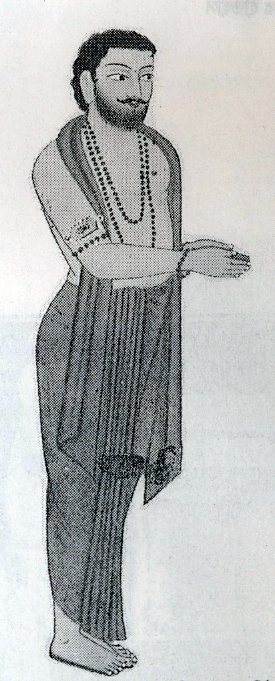
Sadhak Rāmprasād Sen was a Hindu Shakta poet and saint of eighteenth century Bengal. His bhakti poems, known as Ramprasadi, are still popular in Bengal—they are usually addressed to the Hindu goddess Kali and written in Bengali. Stories of Ramprasad's life typically include legends and myths mixed with biographical details.

Rarh region is a toponym for an area in the Indian subcontinent that lies between the Chota Nagpur Plateau on the West and the Ganges Delta on the East. Although the boundaries of the region have been defined differently according to various sources throughout history, it is mainly coextensive with the state of West Bengal, also comprising parts of the state of Jharkhand in India. Linguistically, the region is defined with population speaking the Rarhi local Bengali dialect.

The culture of West Bengal is an Indian culture which has its roots in Bengali literature, music, fine arts, drama and cinema. Different geographic regions of West Bengal have subtle as well as more pronounced variations between each other, with Darjeeling Himalayan hill region and Duars showing particularly different socio-cultural aspects. Culture of West Bengal has adopted many cultural aspects from Bangladesh and shares culture with Bangladesh in many ways.

Kalim Sharafi was a Bangladeshi Rabindra Sangeet singer. He gave his ideas in several publications regarding politics, culture, and Tagore. He is regarded as one of the best Rabindra Sangeet singers in the subcontinent.

Shyama Sangeet is a genre of Bengali devotional songs dedicated to the Hindu goddess Shyama or Kali which is a form of supreme universal mother-goddess Durga or parvati. It is also known as Shaktagiti or Durgastuti.

Bhadu is the social festival of Southern West Bengal, East India. The festival starts from the first day of Bhadro, the fifth month in Hindu Calendar and continues till the end of the month.

Patachitra or Pattachitra is a general term for traditional, cloth-based scroll painting, based in the eastern Indian states of Odisha, West Bengal and parts of Bangladesh. Patachitra artform is known for its intricate details as well as mythological narratives and folktales inscribed in it. Pattachitra is one of the ancient artworks of Odisha, originally created for ritual use and as souvenirs for pilgrims to Puri, as well as other temples in Odisha. Patachitras are a component of an ancient Bengali narrative art, originally serving as a visual device during the performance of a song.
Pannalal Bhattacharya was an Indian singer of Bengali music. Most of the songs he sang were written by Ramprasad Sen and Kamalakanta Bhattacharya, both of whom were Shakta poets of Bengal. He was eight years younger than his elder brother Dhananjay Bhattacharya. He developed a special style of singing, Shyama Sangeet, that continues to be used. He committed suicide at the age of 36. Pannalal Bhattacharya is the evergreen singer of Bengali music industry. Pannalal Bhattacharya is a great Matri Bhakta.
Culture of Bankura district refers to the culture of Bankura district in the Indian state of West Bengal.
Manbhumi or Manbhumi Bengali is the local Bengali dialect spoken in the district of Purulia, and adjacent area of other districts of West Bengal and Jharkhand, previously Manbhum, in Eastern India. It is one of the Bengali dialects, having some influences of neighbouring dialects of Odia in it. Manbhumi has a rich tradition of folk songs sung in various occasions. Tusu songs are sung by village girls during a month-long observance of Tusu festival in villages of Purulia and some parts of Barddhaman, Bankura and Birbhum districts of West Bengal and parts of East Singhbhum, Saraikela Kharsawan, Bokaro, Dhanbad and Ranchi districts of Jharkhand. Bhadu songs, Karam songs, Baul songs and Jhumar songs are also composed in Manbhumi. Manbhumi songs are used by Chhau performers of Purulia School to depict various mythological events. Chhau is one of the distinguished dance forms of this geographical region which has been accorded the status of Intangible cultural heritage by UNESCO in 2009.
Gopeshwar Banerjee or Gopeshwar Bandopadhyay (1880–1963) was an Indian classical singer and musicologist, belonging to Bishnupur gharana of Hindustani music, which originated in Bishnupur in West Bengal. He was known for his khyal and dhrupad renditions, besides Rabindra Sangeet. He also sang thumri, and most notably the thumri, Kon Gali Gayo Shyam, in Raga Mishra Khamaj, which he popularised. As a musicologist, he published several books of rare compositions with musical notations, including dhrupad and Rabindra Sangeet.
Khiyo are an English fusion band of British and Bengali descent formed in London, England in 2007. The three core members of Khiyo are Sohini Alam on vocals, Oliver Weeks on guitar and piano, and Ben Heartland on bass.

Rabindra Jayanti is an annually celebrated cultural festival, prevalent among Tagorephiles around the world, in the remembrance of Rabindranath Tagore's birthday anniversary. It is celebrated in early May, on the 25th day of the Bengali month of Boishakh, since Tagore was born on this day of the year 1268 of the Bengali calendar. Every year, numerous cultural programmes and events, such as: Kabipranam (কবিপ্রণাম) – the songs, poetries, dances and dramas, written and composed by Tagore, are organised in this particular day, by various schools, colleges and universities in Bengal, and is also celebrated by different groups abroad, as a tribute to Tagore and his works. Throughout the globe, Tagore's birth anniversary is largely celebrated at Santiniketan, Birbhum in West Bengal, chiefly in Visva-Bharati University, the institution founded by Tagore himself for the cultural, social and educational upliftment of the students as well as the society. In 2011, the Government of India issued a five-rupee coin to mark the 150th anniversary of Rabindranath Tagore's birth.

The Indian state, West Bengal has a rich cultural heritage. Due to the reign of many different rulers in the past, arts and crafts in West Bengal underwent many changes giving an artistic diversity today in the forms of traditional handicrafts, terracotta, painting and carving, dances and music.

Patua Sangeet or Poter Gan is a cultural tradition of Bengal Patachitra. It is performed by a Patua. It is famous in the village part of West Bengal like Birbhum, Jhargram, Bardhaman and Murshidabad as a folk song of West Bengal.
Ramprasadi is the songs composed by eighteenth century Bengali saint-poet Ramprasad Sen. They are usually addressed to Hindu goddess Kali and written in Bengali language.
